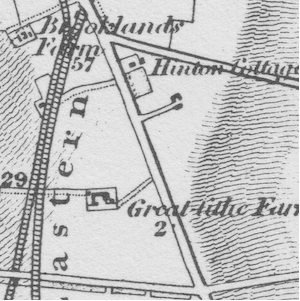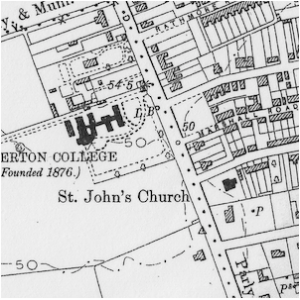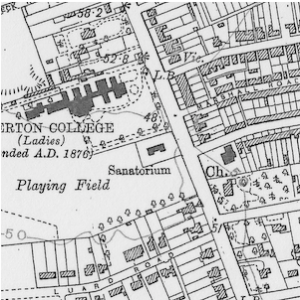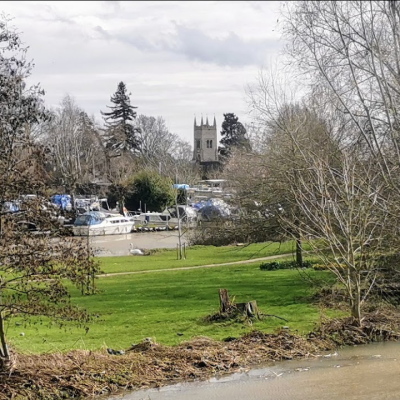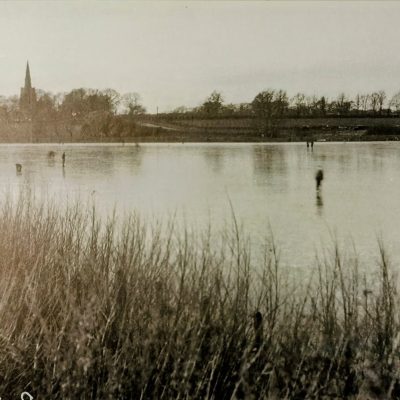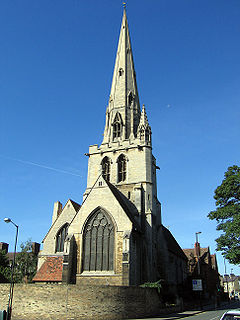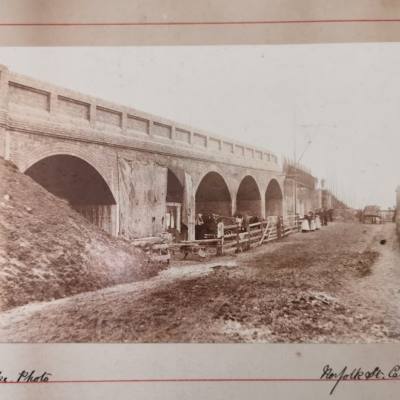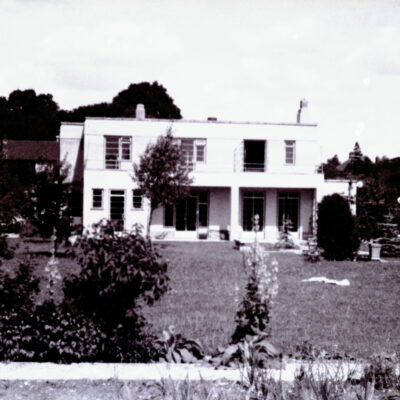Search by topic
- archaeology
- Building of Local Interest
- charity
- church
- crime
- dressmaker
- fire
- Great Eastern Railway
- Listed building
- Mapping Relief
- medieval
- oral history
- poverty
- Public House
- Rattee & Kett
- Religious House
- Roman
- scholar
- school
- Then and Now
- tudor
- women
- work
- world war one
- world war two
Search by text
St John the Evangelist, Hills Road, Cambridge
St John Church history archive uploaded to Capturing Cambridge August 2023
Our history
The church of St John the Evangelist was founded in 1891 as the Cambridge residential area extended south of the city into the land between Hills Road and Cherry Hinton Road. In the early days it had neither building nor clergy. The first congregation met in the chapel of Homerton College (then called Cavendish College). St John’s was founded as the daughter church of St Andrew’s church, Cherry Hinton, but the distance from St Andrew’s (2.5 miles) meant that the services were normally led by local clergy or chaplains from the University colleges.
In the early days, the efforts to establish the church and raise funds for a building were undertaken by a committee with members drawn from the local community and the University of Cambridge, under the chair of the Master of Peterhouse. After only a short while a retired clergyman, the Reverend John George, offered to serve as curate-in-change on a voluntary basis (1893). He played a significant role in the project to build the new church; he and his wife donated the pulpit to mark their silver wedding anniversary. The first stage of the church building was made usable by the end of 1897, and Rev George became St John’s first vicar that year. He served until 1903; a plaque on the chancel wall commemorates the work of the Rev George, and two stained-glass windows in the chancel were given in memory of the Rev George and his wife Edith.
The second vicar, Reverend Love, served 11 years (1903–1914), and oversaw the building of the the choir and clergy vestries (1909). He was followed by Reverend Jackson (1914–1927), who oversaw the building of the Parish Hall on the corner of Blinco Grove and Baldock Way, which served as the base for the Sunday School. This period overlapped the tragedy of Great War, which saw the death of 45 parishioners in service in the armed forces. In spite of the war, efforts to raise funds for the building of the church continued, and it was possible to complete the extension of the west half of the church in 1929 during the priesthood of Reverend Patterson Morgan (1927–1938). The tragedy of the Second World War occurred during the priesthood of Reverend Robert Jary (1938–1947), and the church served the local community and the forces in a number of ways. A period of consolidation of parish work, particularly with young people, followed during the priesthoods of Reverend John Needham (1947–1955) during which time the organ was installed, and Canon Frederick Stanbury (1956–1974). During the priesthood of Canon Frederick Wilkinson (1975–1988) a new parish room was built on the South side of the church, which was extended during the time of his successor, Canon Brian Jones (1989–1997). This marked the end of the building of the church. Canons David Reindorp (1997–2006) and Susan Wyatt (2006–June 2016) have subsequently led St John’s in further establishing the work of St John’s in the local area.
Over the years St John’s has been fortunate to have had a number of wonderful curates and honorary priests. Some of these have gained national attention. One curate, Stephen Sykes (1985–2006) was Regius Professor of Divinity at the University of Cambridge, and subsequently served as Bishop of Ely. Before being ordained as Vicar of St Bene’t’s in Cambridge, the Reverend Angela Tilby served as honorary priest from 1997–2006; Angela is well-known for her work on BBC Radio 4, particularly as a regular contributor to Thought for the Day and the Morning Service. A previous vicar, Reverend Canon David Reindorp, was chaplain on the television series Lad’s Army and other reality-style programmes.
Incumbents
Rev James Shakespeare 2017 –
Rev Canon Sue Elizabeth Wyatt 2006-16
Rev Canon David Peter Edington Reindorp 1997-2006
Rev Canon Brian Noel Jones 1989-1997
Rev Canon Charles Frederick Wilkinson 1975-1988
Rev Canon Frederick Elwyn Stanbury 1956-74
Rev John Needham 1947-1955
Rev Needham and the St John’s Players
Rev Robert J A Jary 1938-1947
Rev J Patterson Morgan 1927-1938
Rev G F Jackson 1914-1927
Reverend A E Love 1903-1914
Reverend John George 1897-1903
Historical list of church officers
Rev. John Hillier: current
Rev. Peter Heslam: current
Rev. Angela Tilby: 1997-2006
Curates and Assistant Priests
Rev. Ceri Payne 2021 –
Rev. Muthuraj Swarmy 2020 –
Rev. Christine Campbell 2018 – 2021
Rev. Petra Shakeshaft: 2014 – 2017
Rev. Charles Fraser: 2010 – 2015
Rev. Julie Gawthrope: 2010 – 2015
Rev. Lesley Gore: 2007 – 2009
Rev. David Theaker: 2005 – 2006
Rev. Peter Heslam: 2005 –
Rev. James Shakespeare: 2000 – 2003
Rev. Angela Tilby: 1997 – 2005
Rev. Howard Bigg: 1995 – 1996 and 2010
Rev. Richard Darmody: 1995 – 1996
The Rt. Rev. Canon Professor Stephen Sykes: 1988-1990 (Bishop of Ely 1990-2000)
Deaconess Elisabeth Hubbard: 1987 – 1992
Deaconess Margaret Guite: 1985 – 1986
Deaconess Margaret Hutchison: 1983 – 1984
Rev. Alan P.C. Smith: 1979-1982
Rev. P.T. Kerr: 1977-1978
Rev. N. Taylor: 1973-1974
Rev, B.R. Buchanan: 1970-1972
Rev. J.B. Corfield: 1967
Rev. R.S.Dell: 1966 (Vice President Ridley Hall)
Rev. C.T.E.Birks: 1953-1961
Rev. P.V.R. Pennant: 1949-1952
Rev. Freeman-Manners: 1943
Rev. Greenough: 1942
Rev. E.B.Evans: ?? 1941
Rev. Sidney Pay: 1940
None ? 1928-1939
Rev. A. Malley: 1924-1927
Rev. Ivor Jones: 1920-1923
Rev. John George: 1893-1897 (Curate in Charge, from 1897 1st Vicar)
Vergers
? R. Brooks: 1957 -1967
? Herbert Jackson: 1941-1962
Edward Baldock: 1897-1921
Organists
Elizabeth Trenchard: 2002 –
Roger Lilley: 2001 – 2002 (temporary)
William Janssen: 2000 – 2001
Dr. Malcolm McLeod: 1995 – 1999
Stephen Burrell: 1981-1994
Peter Charlton: 1976 – 7 (temporary)
A.G.Chapman: 1961 – 1975 ??
Arthur George Noble: 1930 – 1950
Mr. Maltby: ? – 1929
Mr. Cope: 1904
Churchwarden Emeritus
Peter West: 2009 –
Reg Grimes: 1988 –
Churchwardens
Julia Margretts 2021 –
Joseph Philip 2021 –
Gail Kenney 2017 – 2021
Michael Fincham 2015 – 2017
Derek Swanson 2015 – 2019
Helen Smith 2011 – 2014
Richard Lyon 2009 – 2015
Hilary Pennington 2009 – 2011
Fay Elbourn 2004 – 2005
Carol Hatfield 2000 – 2001
Dominic Barton 2000 – 2002
Trevor Mawby 1997 – 1998
Peter West 1996, 2002 – 2003 and 2006 – 2008
Sue Malec 1995 – 1999
Michael Johnson 1993 – 1995
Doug Gunnary 1990 – 1992
Helen Gardner 1990 – 1994
Roy L. Bailey 1988 – 1989
Bridget Garton 1985 – 1989 and 2006 – 2009
Miss Marjorie I.M. Bunett 1981 – 1982
Stephen Burrell 1980 and 1999
R. Brook 1974 – 1976
Reg Grimes 1971 – 1987
J.B.Finney 1976 – 1979
R.J. Brooks 1974 – 1976
T.E Ticehurst 1970 – 1971 and 1983 – 1984
J. A. Telford 1970 – 1973
Lawrence H. Shelton 1963 – 1969 (Vicar’s Warden)
Thomas Russell 1952 – 1963 ? (Vicar’s Warden)
A. Coleman 1947-1949 (Vicar’s Warden)
Alex. E. Yarrow 1947-1969 (People’s Warden)
C. J. Whittaker 1941-1946
Frank Foster Doggett 1940-1946
H. E. Percival 1939-1940
L. H. Shelton 1938-1940
R. M. Johnson 1934-1938
Harry Herbert Dickson 1923-1937 (People’s Warden)
H. J. McCullough 1920(?) -1933
??? 1915-1920
H. C. Apthorpe 1915
W. H. Rain 1915
? 1914
William Cutlack (Sen) 1913
A. E. Machin 1913
? 1911-1912
E. Vintner 1910
William Kett 1908
F. W. T. Oldham 1907 – 1908
Isaac G. Elworthy 1907
? 1905-1906
William Wilson 1904
A. Onyett 1904
? 1902-1903
Joseph Clark 1901
William Kett 1901
? 1899-1900
Mr. Barnes 1898
Mr. Long 1898
John Jenkin 1894-1897
Isaac G. Elworthy 1891- ? 1894 ?
Sources:
St. John the Evangelist records
Parish Magazines 1957-2017
Cambridgeshire Collection, Central Library
Spaldings Directories 1898, 1901, 1904, 1907, 1910, 1913, 1915,
Spaldings Handbooks
Parish Magazines
1952, 1953, 1954, 1957, 1958, 1959, 1960, 1961, 1962, 1963, 1964, 1965, 1975, 1976.
Cambridgeshire Archives, County Hall, Castle Hill
Ref. P39A/8/3, St. John Parish Church, PCC Minutes 12/4/1920-28/1/1931,
Ref.P39A/8/4, St. John Parish Church, PCC Minutes 11/2/1931-24/3/1947,
Ref P39A/8/5, St. John Parish Church, PCC Minutes 8/4/1947-17/4/1963
Compiled by Richard Lyon 10th May 2017
History of our building
The story of St John’s Church buildings began around the year 1892. At that time the land on which the church stands was an empty plot, and new residential housing was being developed under the title of New Cherry Hinton within the area between Hills Road and Cherry Hinton Road. A committee of town and University people, under the chair of the Master of Peterhouse, was formed in 1891 with the purpose of raising funds for building a new church. The plot was acquired, and a small wooden schoolroom was erected to serve as the premises for a Sunday School. The new congregation first met in the chapel of Homerton College (then called Cavendish College).
By May 1896 fund-raising had reached the point whereby the foundation stone could be laid, and by the end of the year the Eastern half of the present church building had been completed. This consisted of the chancel and two bays of the nave. In order to be able to start to use the part of the building that had been built for services, the West end was blocked off by a wall made from yellow Cambridge bricks. The architects were Gordon, Lowther and Gunton.
The next stage in the building was the construction of the vestries for the clergy and choir in 1909. Progress was then stalled by the Great War of 1914–18. After the war efforts were renewed to raise the funds required for the church to be extended to the size of the original plans, and by 1929 it was possible to complete the building, at least to a revised design. The original plans had included a tower and spire; those who worry about church finances today are relieved that these were dropped from the final plan!
Subsequent to the completion of the church was the development of the community rooms on the South side of the church. The original community room was built in 1982, and later extended, with the provision of a new entrance area, in 1995.
Historic Maps
The Ordnance Survey maps tell an interesting story about the history of the parish.
The 1865 edition of the one-inch-to-one-mile map of the Cambridge area (the first printed using electrotype setting) shows that southern reaches of the residential development of Cambridge only extended as far as the area of land that is now the University Botanic Garden, and the railway station (opened 20 years previously) is completely outside the residential area. The main thoroughfares of Hills Road, Cherry Hinton Road and Long Road, which partly define the parish boundary, were in existence in 1865, but at this time there was no hint of Mowbray Road, which is the other parish boundary thoroughfare.
The first 6-inches-to-a-mile map of the area was published in 1889. What is now Homerton College was then still Cavendish College. The site that is now our church was part of Jordan’s farm (this can be seen in the 1865 map but without the name being given). Virtually the whole of the modern parish of St John’s was farmland. The only parish roads that appear to have been designated – albeit without any buildings – were Cavendish and Hills Avenues. At this time most of the parish lay outside the Cambridge town boundary (note that at this time Cambridge did not have the designation of a city; this was awarded in 1951) and instead was part of the village of Cherry Hinton. The only part of the parish lying within Cambridge was the land around the junction of Hills Road and Cherry Hinton Road.
The 1904 map takes us to just after the foundation of the church of St John’s, which then was only half the size of the current church building. We can see how quickly the residential area in the western part of the area bounded by Hills Avenue, Hills Road and Cherry Hinton Road has developed since 1889. There is still no sign of Mowbray Road, or any development in the southern part of the parish.
In the 1925/7 revision of the maps, we see the wider development of the parish. This now includes Mowbray Road (although not yet Perne Road, which today is the northern extension of Mowbray Road forming the modern city ring road). There is a larger density of housing, including building along Cherry Hinton Road and Hills Road. By this time the city boundary has been extended to include the residential area of the parish of St John’s, which forms the edge of the city. This map still precedes the extension of the church.
Contribute
Do you have any information about the people or places in this article? If so, then please let us know using the Contact page or by emailing capturingcambridge@
License
This work is licensed under CC BY-NC-SA 4.0





